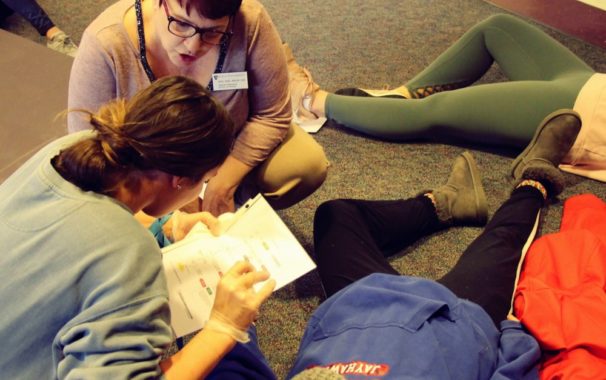The Avila University School of Nursing put on its first Disaster Preparedness simulation this Wednesday, offering its senior students a hands-on experience providing medical care in the midst of a disaster.
Taking place in the Goppert Theatre lobby, the 39 students split into two groups: the first responders who came to the aid of the second group, the victims of a simulated tornado disaster. They then reversed roles allowing some students to view the situation from both perspectives. Assistant Professors, Lynn Gallagher, MSN, RN, CNE, and Simulation Coordinator Angel Yanez MSN, RN, CHSE oversaw the simulation.
“We were looking to provide our students with more practical experience,” Professor Gallagher said. “The sort of situations they’ve encountered in this simulation are things that will be covered by their licensing exams. This simulation reinforces some of the lessons that we’ve been teaching our students over the past two years. We hope that this practical experience will help some of those lessons stick.”
The School of Nursing has long utilized simulations in its curriculum. Juniors participate in less detailed simulations compared to those undertaken by senior students. Professor Gallagher said the disaster simulation offers a new challenge to seniors, requiring them to think and act in less than ideal conditions.
“We’re trying to give our students an opportunity to utilize their critical thinking skills when faced with this simulation,” she said. “If they were to face a similar situation in the real world, their resources would be limited which makes triaging and priority identification essential for success. By giving our students a chance to identify and access priorities both as a first responder and as a victim, we are trying to give them perspective from both sides of a disaster.”
After each simulation, the group of students debriefed with the faculty and staff on what worked well and what presented challenges. Professor Gallagher said the school hopes to make the disaster simulation a part of the regular curriculum in its efforts to expand and enhance the education it provides its students.
“This model gives the students a chance to be faced with a difficult, but controlled, situation similar to what they could face in the field,” she said. “Simulation has been a staple of nursing for quite a while and more simulation is being used in medical situations. These programs will aid our students to be fully prepared for anything they could face professionally.”

